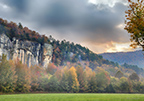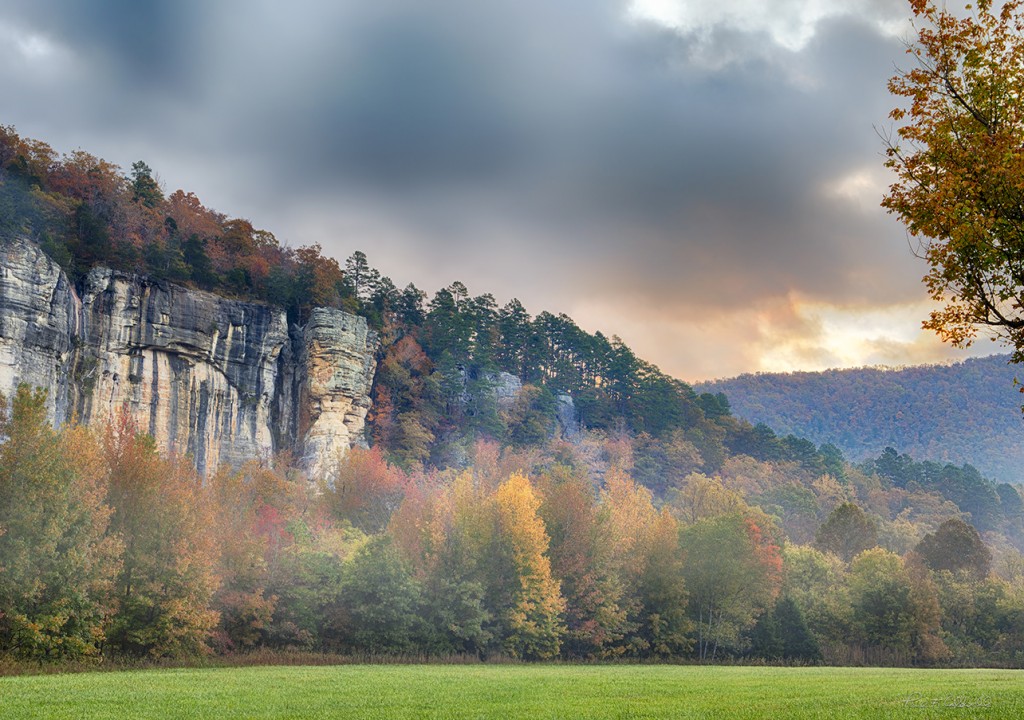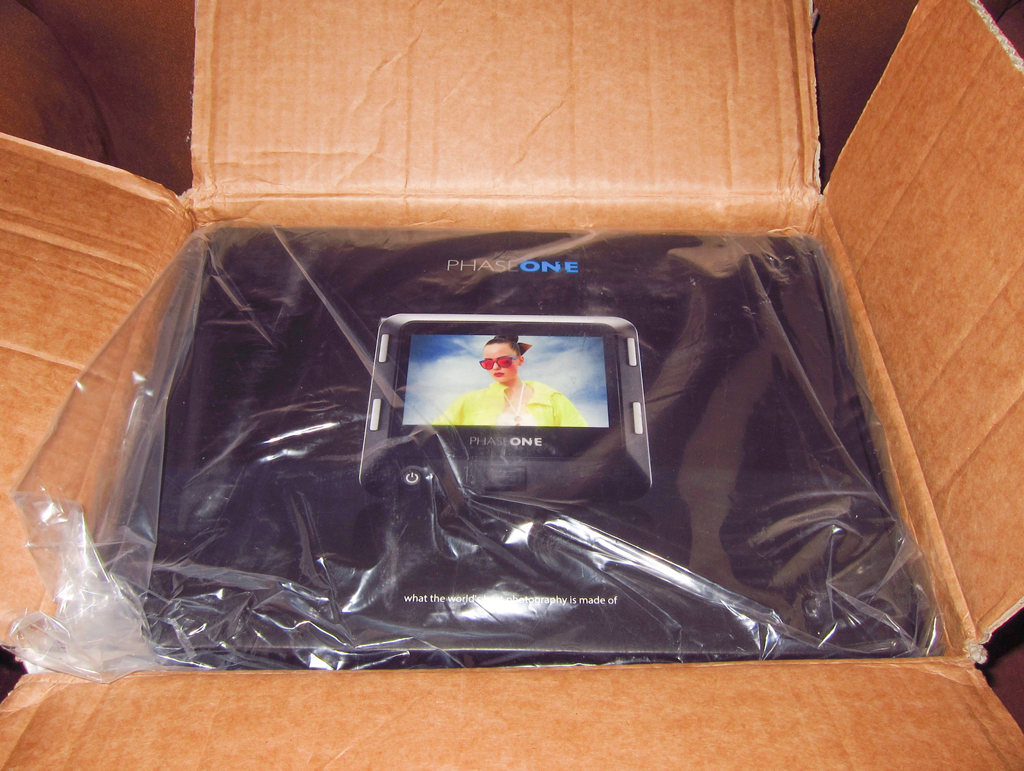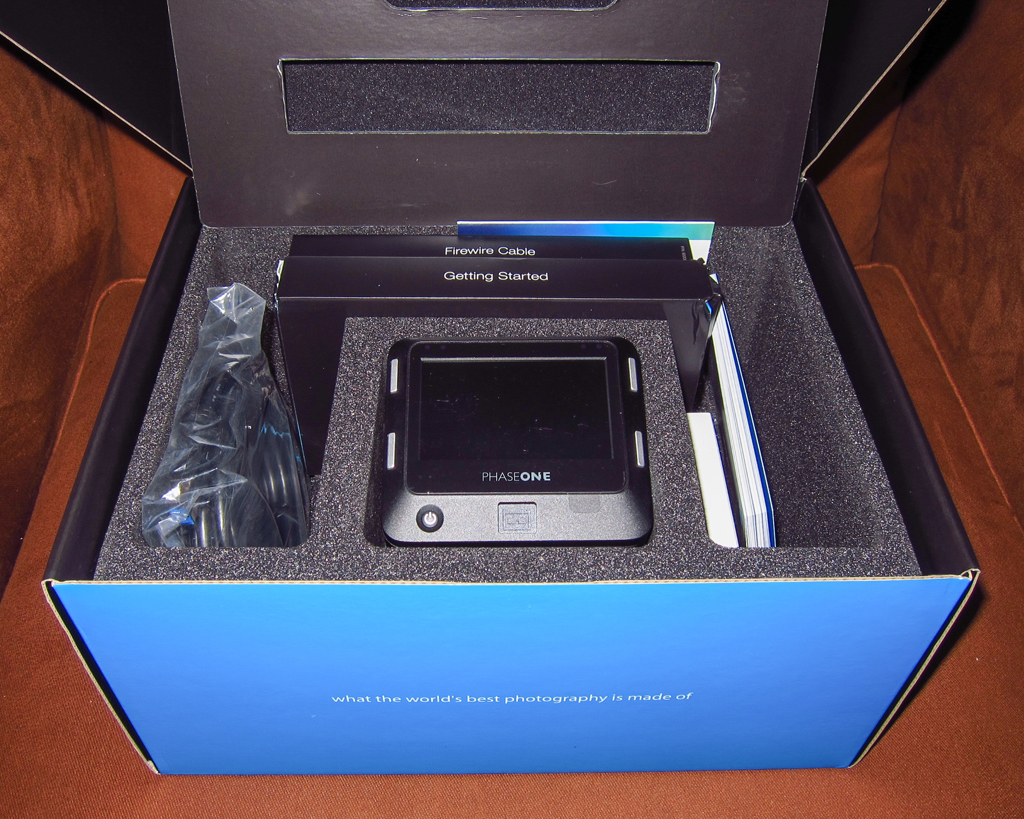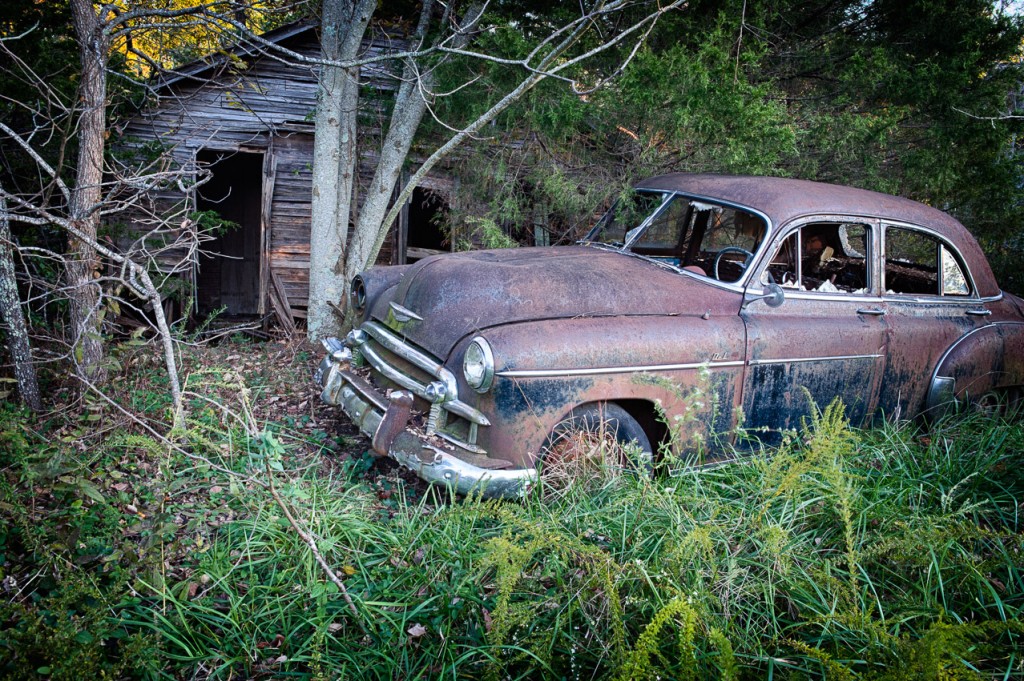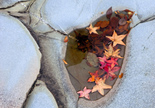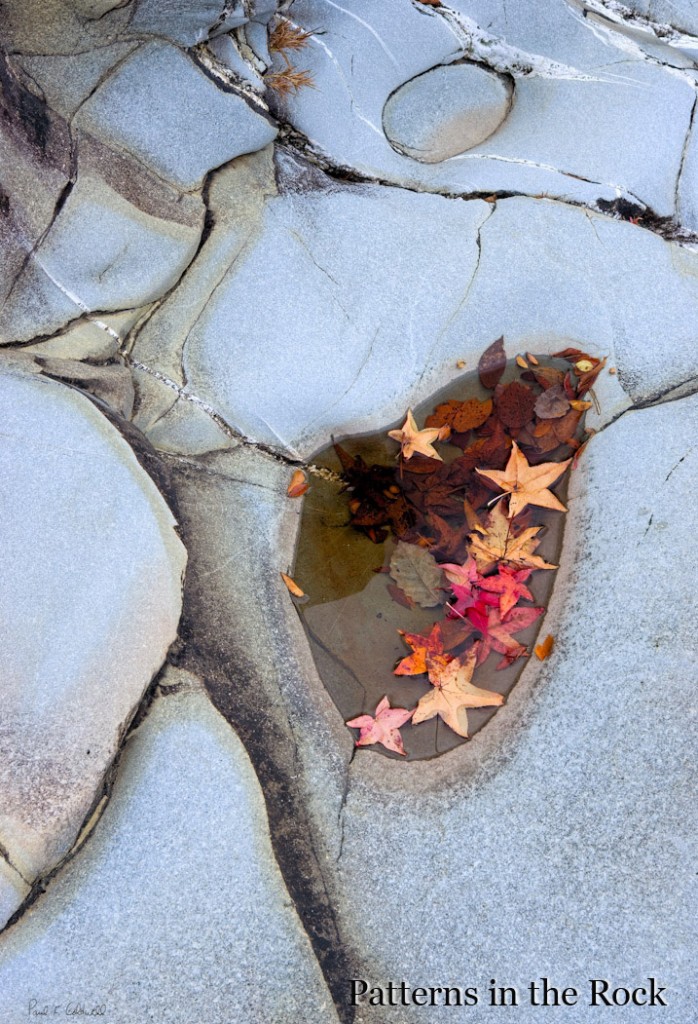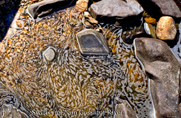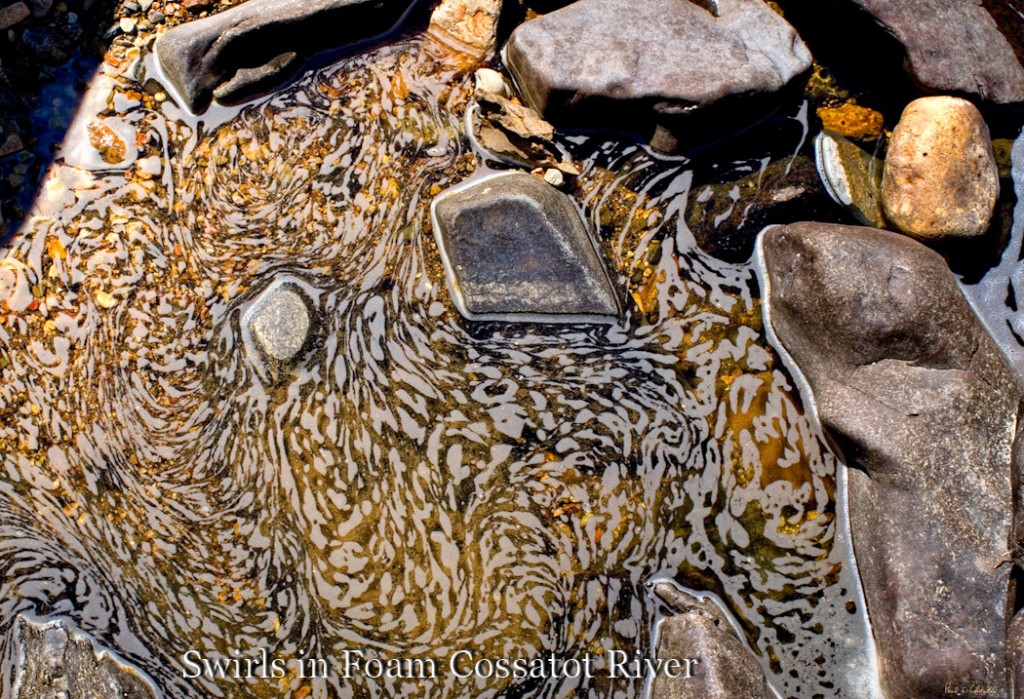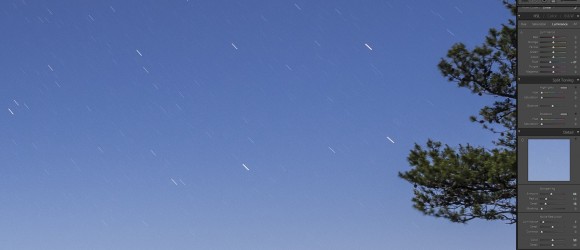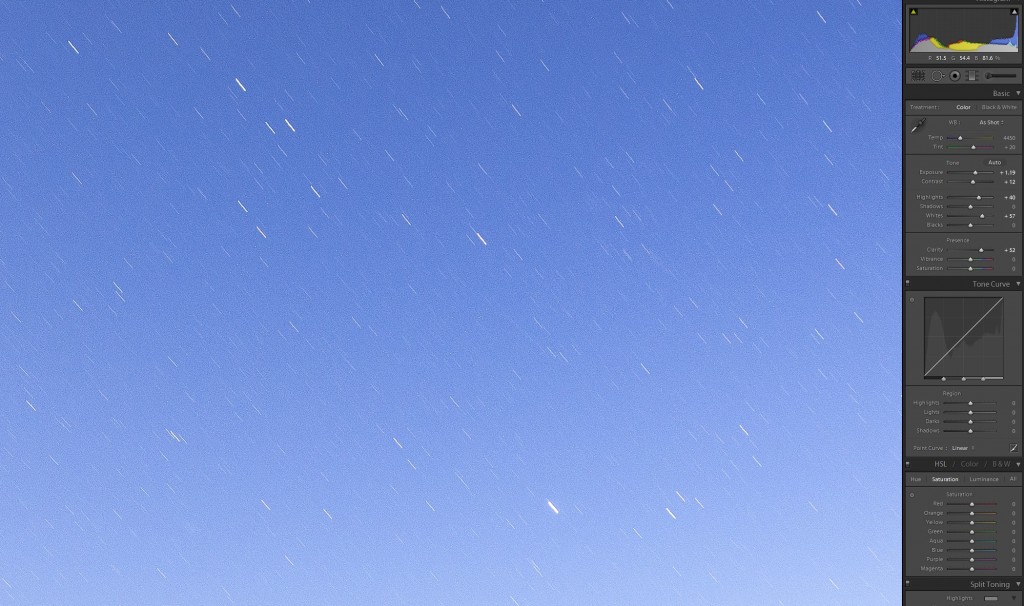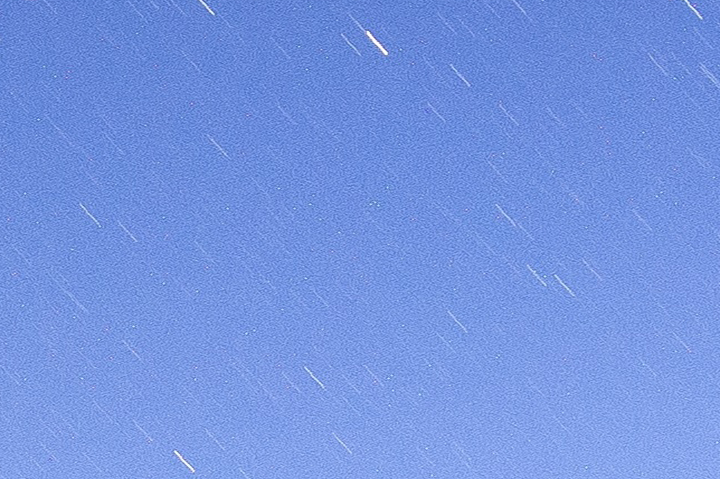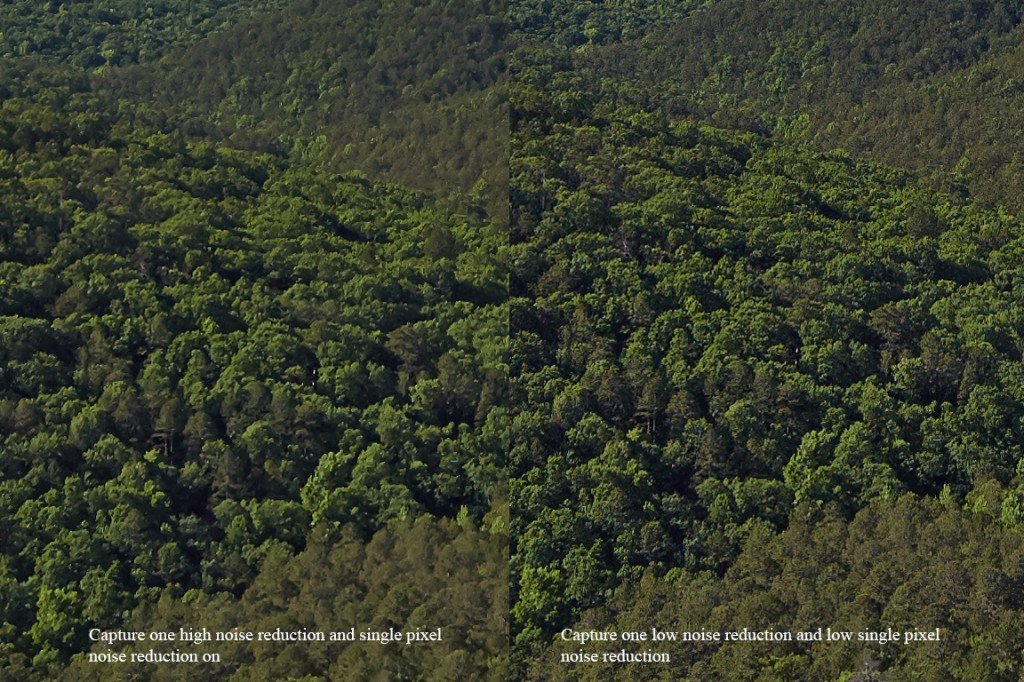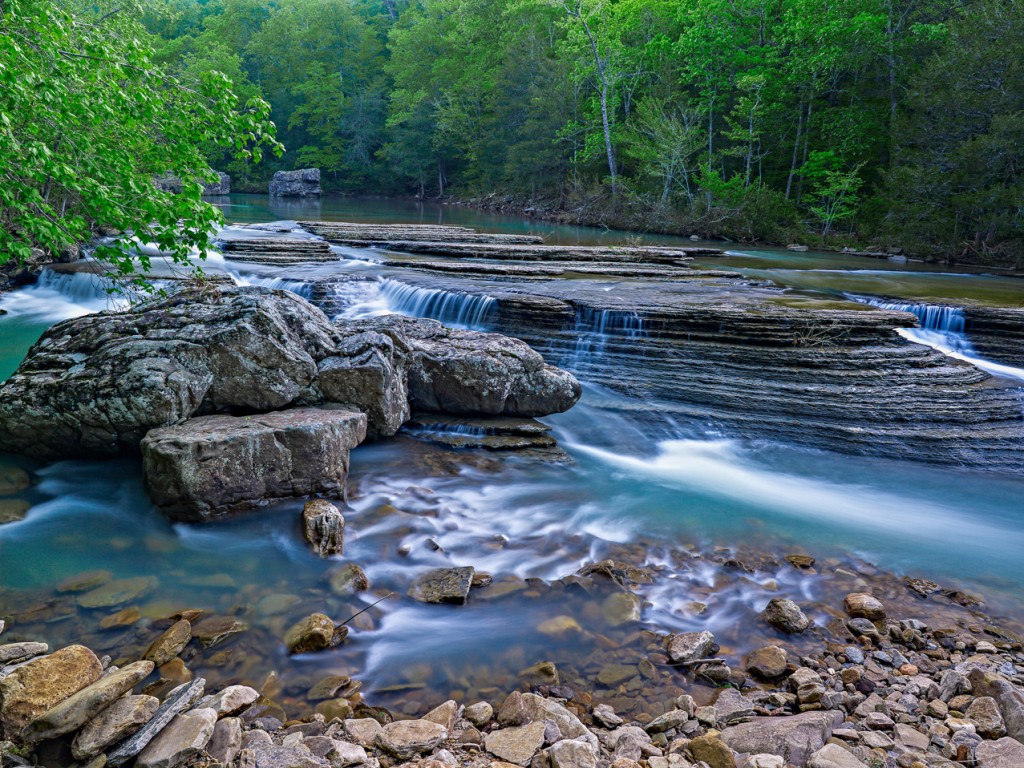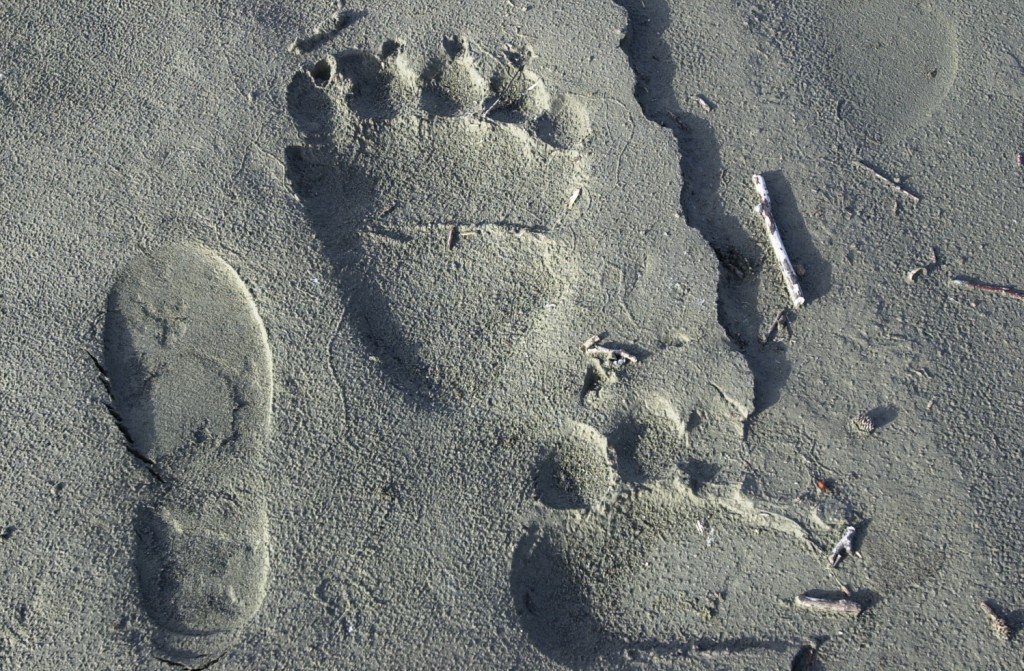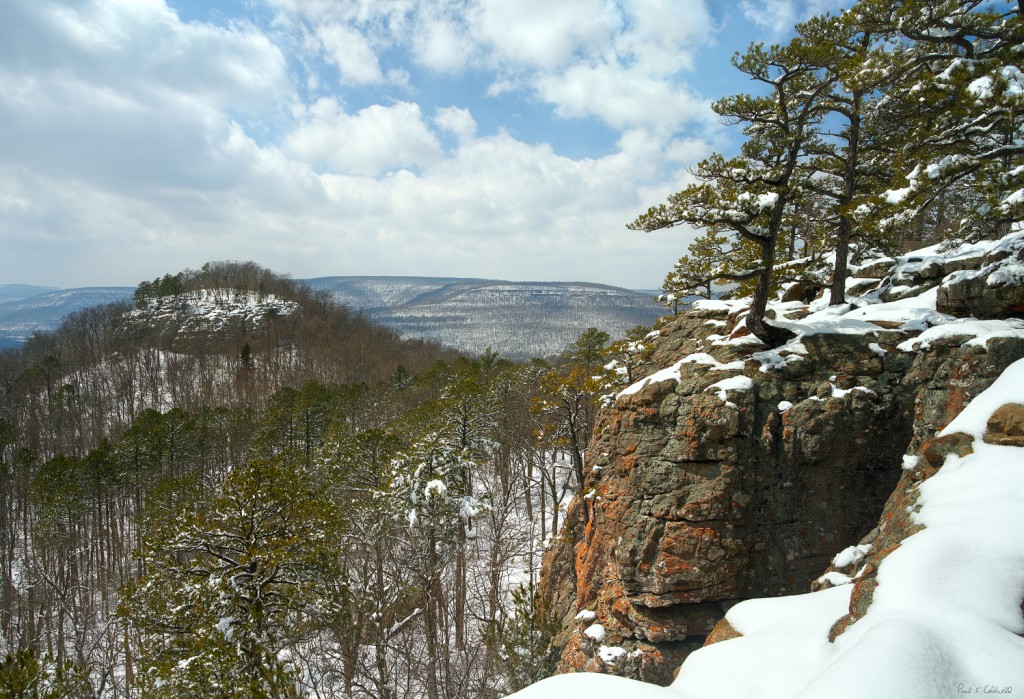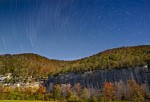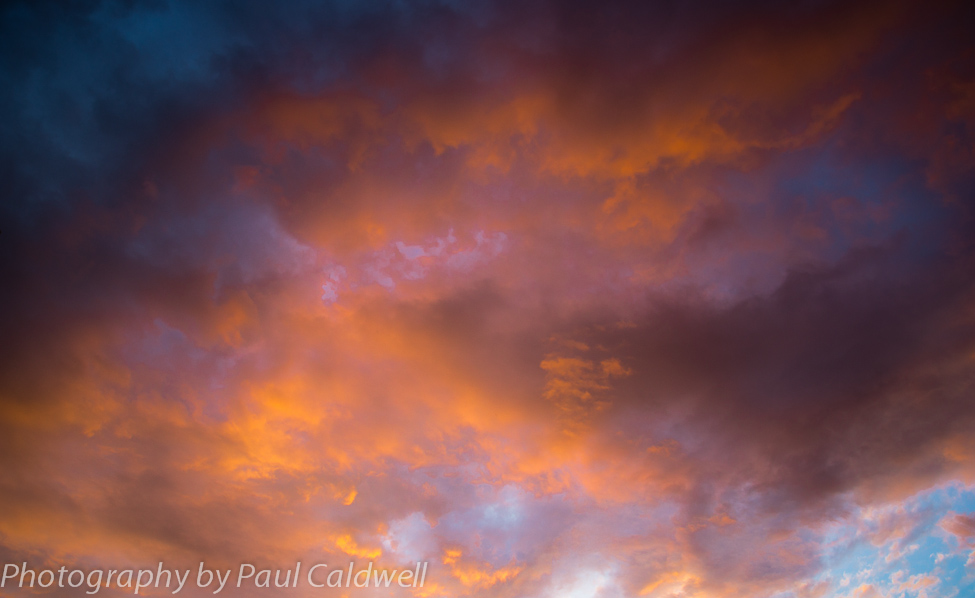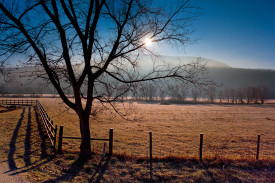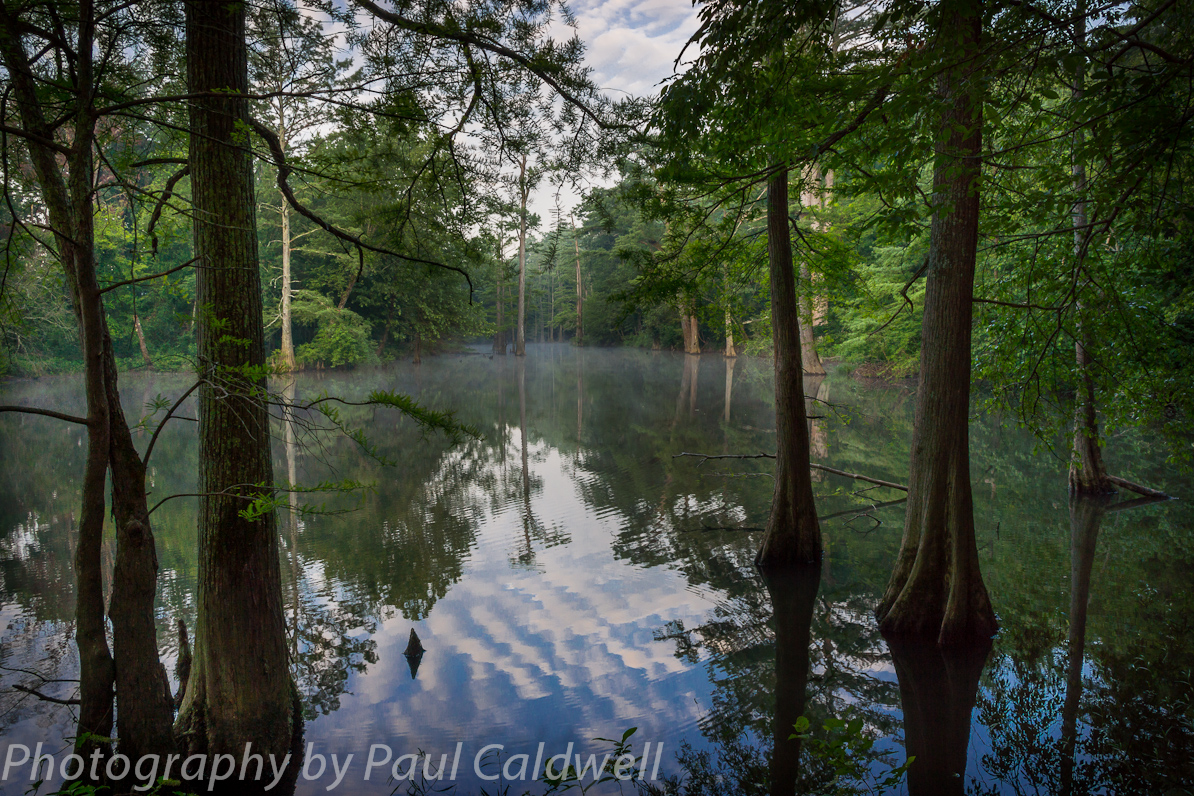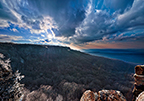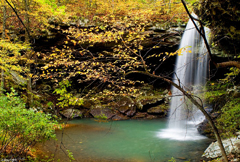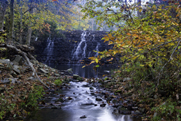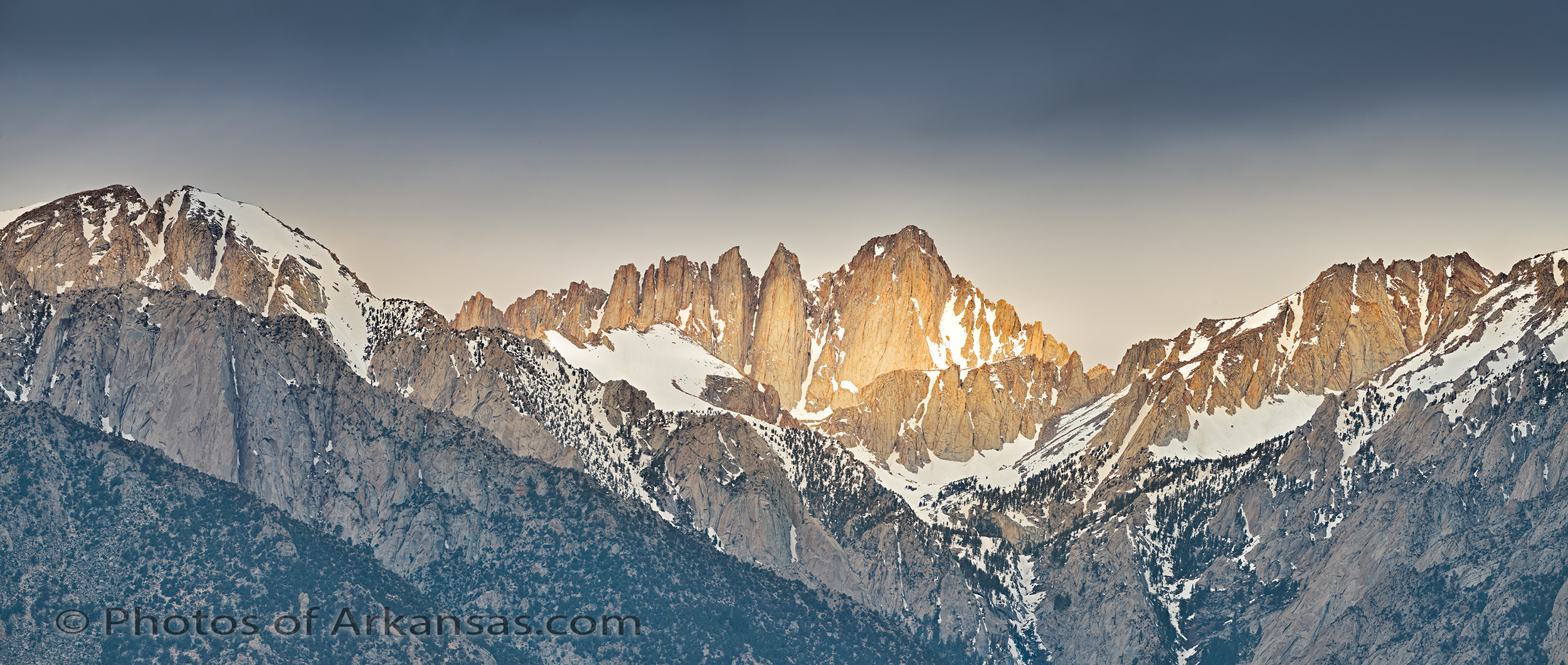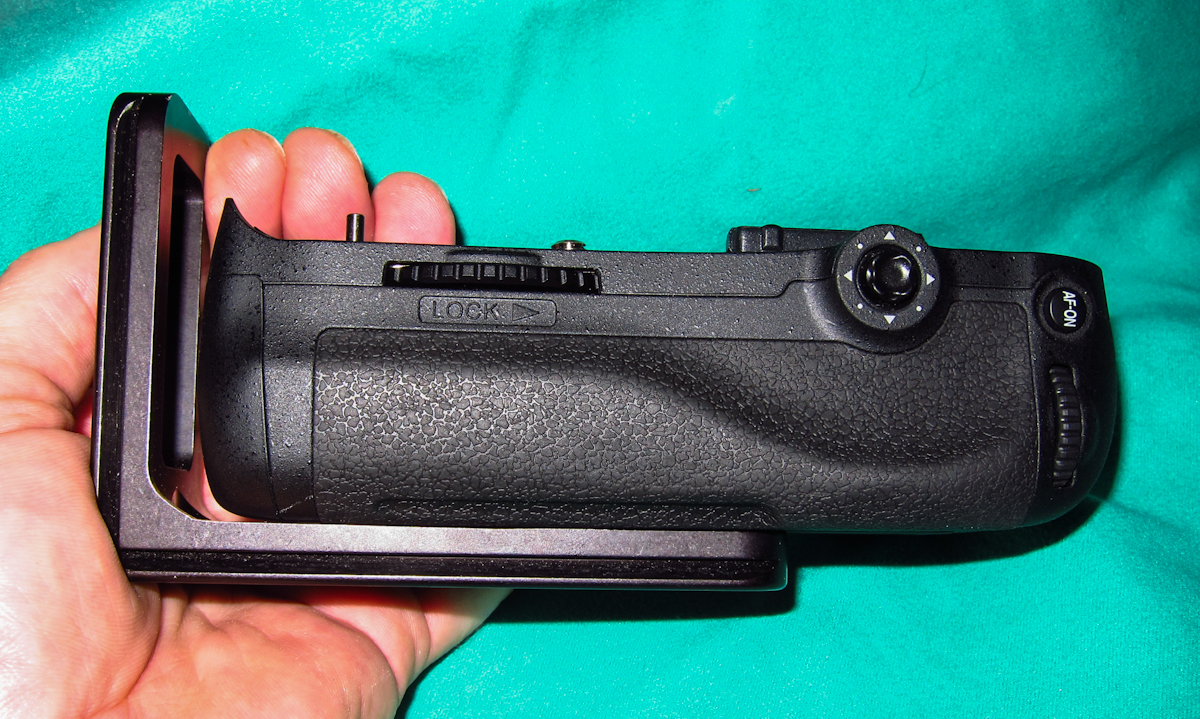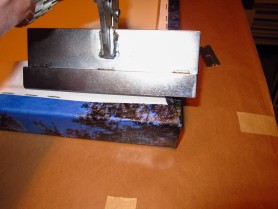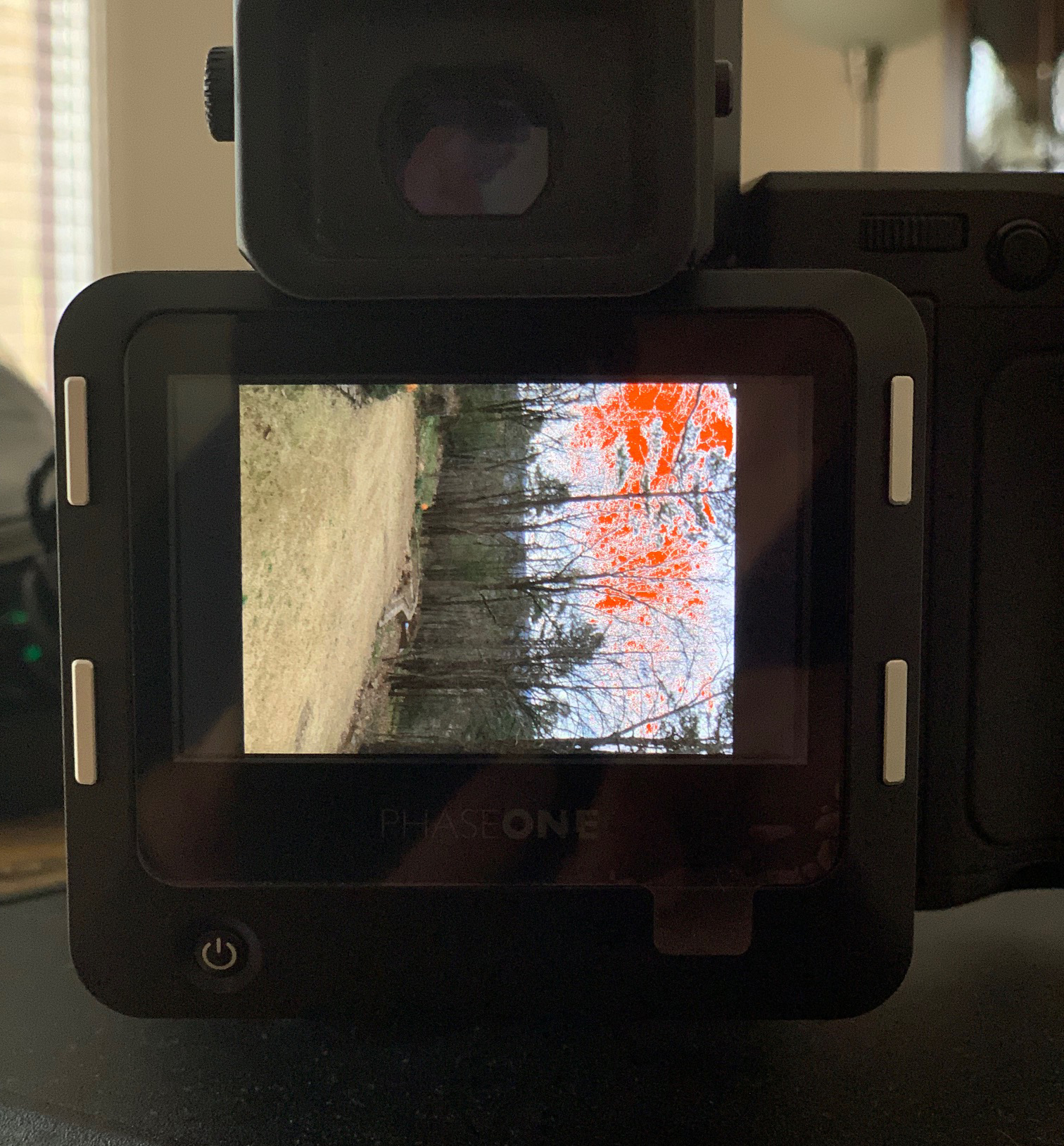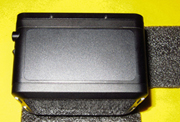09/25/13 Featured Arkansas Photography–A quick preview of things to come, Fall scene on the Buffalo River sunrise over Bee Bluff
Taken with a Canon 5D MKII, Canon 24-70 lens @ F8 24mm, iso 200, bracketed exposures for final image. The Buffalo River has to hold some of the best photographic opportunities in Arkansas, especially in the fall. This shot was taken in 2011 but it’s a great example of what you can expect on the Buffalo. Here you will find almost every tree species that the state has and each one will have a unique fall color, along with the short leaf pines. In this shot you can see a row of sweet gums and maples along the lower part of the bluff and in the background on Bee bluff the oak and hickory trees are making their presence noted also. Fall in Arkansas can be glorious and on the Buffalo tends to peak sometime around mid October. I feel that this year since we have had such a long dry spell that the colors may not be as bold as normal and fall may come a bit earlier than normal. So far no major storms are forecast for Arkansas this fall and the northwest portion of the state is very dry. I was up in this area last week and there were already a few trees starting to turn a bit early. I am hoping that this year will not be repeat of last and the year before where each tree species seemed to turn by itself and there was never a great display of fall color. I was lucky in this shot to catch the last of the morning fog lifting off the ground and still showing up in the maples and gums. I took this shot as a bracketed exposure since I wanted to be able to catch all the light in the sky and not have too much noise in the trees along the bluff.
09/18/13 Featured Arkansas Photography–The Natural Bridge in Lost Valley near Ponca Arkansas
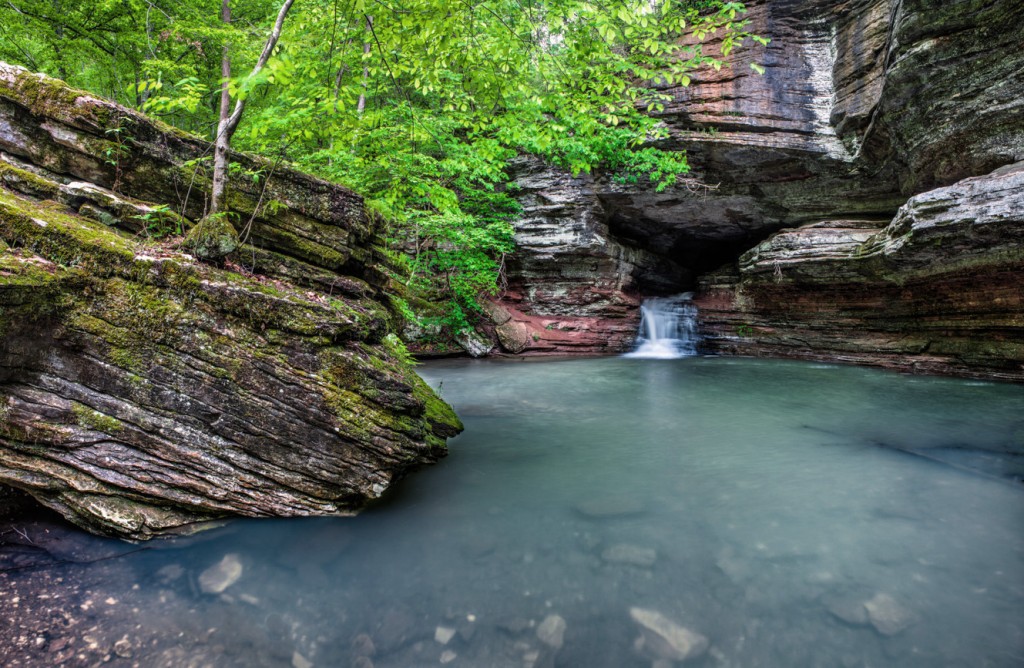
The Natural Bridge in Lost Valley near Ponca Arkansas on the Buffalo River–click on photo for a larger view
Taken with a Phase One P45+ in 3 vertical segments to be stitched into one frame, 35mm Mamiya lens, F14, iso50, 3 second exposures with ND filter and CL-PL. Lost Valley is one of my favorite spots in Arkansas to photograph, especially when there is water running in Clark Creek. I would say that in the 100 or so trips I have made to Lost Valley over the years, I have only seen water like that shown in this picture about 10 times. Clark Creek runs throughout Lost Valley and eventually empties into the Buffalo River above Ponca. This one valley has more scenic value packed into the 1.5 miles of trail than most other places in the Ozarks. You can find over 6 separate waterfalls when the creek is running at full flow. If you have not been there before with a good head of water running in Clark Creek, I would put this on your list of places to visit. You can be sure of good water in Clark Creek if the Buffalo River is running over 2000 cfs when gauged on the USGS gauge at Boxley. Lost Valley can also especially pretty in the dead of winter if you happen to catch it after a heavy snow.
07/17/13 IQ260 Arrives in Little Rock Arkansas–The unboxing
I can remember back when I was a fan of collecting watches, when someone purchased a new watch, they always published an “unboxing”. I never did it for a watch, but did go ahead for the IQ260. I am pretty sure this is the first one in Arkansas and I am very happy to be the owner.
After a lengthy decision process, I upgraded my IQ160 go the new IQ260. I have been on the fence for quite a time on this but after working with Digital Transitions, out of New York I found that there was enough value in the IQ260 to move from the 160. I was able to demo the IQ260 in Dallas TX, on a hot clear day. The outside temperatures were approaching 100 degrees so longer exposures were out of the question. However I was more interested in the file quality of the IQ260 vs. the IQ160. I was hoping to see a bit more room in the shadows and a bit more top end with highlights. I was also interested to see if there was much improvement in iso 200 and iso 400 results in the long exposure mode. These are areas where I tend to get pushed with my my outdoor photography. The IQ260 at first blush does seem to provide a bit more top end at iso 200 and 400 and definitely seems to show a smoother tonality in the shadows. Since I moved to the IQ160, I have never seen the need for any larger MP output. The IQ280 loomed on the horizon but since I am mainly a tech camera user with Schneider lenses, I was not ready to make the switch to 80mp.
One consideration that I considered was where Phase One was in the development stage of the IQ160 vs the IQ260. The IQ160 was the same chip as the older P65+. Images are identical. However with the IQ160, you picked up the excellent IQ interface to the back. I feel that Phase One will continue to produce enhancements to the IQ260 over the next year or so, whereas I don’t think there will be any more improvements to the IQ160/P65+. I am betting on the future here. It’s also the 1st new chip that Phase One has brought to the market in over 2 years. The IQ280 is still based on the same chip as the older IQ180, however it does have a newer processor/logic card that supposedly gets a bit more DR from the current chipset.
I had also looked at the financial situation on the upgrade (something many people don’t seem to consider when making such a large purchase). My IQ160 was fully depreciated so I wasn’t going to take a book loss. Also after reviewing the numbers that Digital Transitions shared with me for the trade in, I felt better about trading in my IQ160.
One nice new feature is the ability to review the images in Black and White. It’s not a black and white conversion, but if you are looking for focus checks, depending on the lighting, viewing the image preview in black and white is sometimes easier. It’s my understanding that the latest version of the firmware for the IQ160/180 also will have this feature.
As I mentioned I worked closely with Digital Transitions, my dealer out of New York, I was able to demo the IQ260 against my IQ160. So far I have found several areas where I believe the IQ260 is superior to my older IQ160.
- Better tonal transition from shadow to lighter areas at iso50
- Very clean 60mp image at iso140, cleaner than my IQ160 at iso100
- The ability to glean an extremely clean file at iso140 in Long Exposure Noise Reduction mode
- Wifi connectivity to an iPad for checking focus on Tech camera shots.
I have not been able to do anything in the long exposure mode due to the extreme heat we are experiencing here in Arkansas and more than likely will not be able to test this feature until late September or October.
It’s interesting to note, that the wifi feature has actually become a more positive feature for me than I first realized. I originally felt that the wifi feature would be moot for me, but with a bit of trial, I am finding that it’s actually a very important feature, especially for tech camera work. Since all the IQ’s (for that matter all current Phase One backs) use CCD instead of CMOS chips, live view as most people are used to does not work. Yes Phase One offers Live View on the IQ backs, but in actual daytime use it’s not very helpful. With the wifi feature, you can shoot a series of images with the back on a tech camera, then view them with Capture Pilot on a ipad, This allows you much more flexibility to check your shots. Sure the IQ LCD is loaded with features, but it’s still small and it’s also locked into position on the tech camera. Many times I will setup a shot on my knees or bent over double. Exposure is easy but bending over to see the screen is harder and even then it’s a bit difficult to see all the details. With the wifi feature, you can leave the camera in position, and pull out the ipad and find a comfortable viewing position to check the images. You can also delete them from Capture Pilot. Sure it adds one more thing to carry, but it’s not a bad compromise.
I hope to add a lot more to this report as I get out and shoot the IQ260. One thing I found surprising, it seems that speed of the processor in the IQ160 and 260 is about the same. I base this on the fact that the latency between shoot and review is pretty much the same.
Thanks again to Digital Transitions for all of their help in making this upgrade possible.
08/23/13 Featured Arkansas Photography–Rocks and Leaves on the Cossatot River
Taken with a Canon 1ds MKII, iso 200, Canon 24-70 Lens @70mm, 1/60th of a second. The Cossatot River is one of my favorite spots to hike. You have all sorts of photographic subject matter to work with. The Cossatot River is in the southwestern corner of Arkansas Ouachita Mountains. You can find some of the best photography in the area known as the 6 falls or Cossatot Falls. Here the river turns due south and drops over 6 separate ledges, each of which have unique rapids and names. The rocks around Cossatot Falls are sandstone and have been worn totally smooth by the action of the water. You can find all types of interesting formations, such as the one in the photograph above where lines of quartz are running through the rocks.
08/09/13 Featured Arkansas Photography–Swirls in foam on the Cossatot River
Taken with a Canon 1ds-MKII, Canon 24-70 lens, 24mm, F9 for 1/125 of a sec, iso 100. The Cossatot River has a wide range of photographic subject matter. When the water is running high you can make a trip down to catch the kayakers running Cossatot Falls, and when the water gets lower, you can look for unique spots along the riverbank to work. Most of the rock along the river is sandstone and tends to have a reddish hue in most places. The best place to catch the kayakers is at Cossatot Falls. Here you can perch on one of the rocks for the best view. The falls consist of 6 separate drops and each has a unique name. The most famous drop is the “washing machine” which tends to get the most attention. The only problem with the Cossatot is the fact that it’s about a 3 hour drive from Little Rock so a trip there makes for a rather long day.
Swirls in foam has been printed on both canvas and Canon Platine rag. It makes an excellent print and can be displayed in both the horizontal and vertical orientation.
D800 Reticulation issues during night photography–white dot problems
- At August 02, 2013
- By paul
- In Articles/Reviews, Nikon Gear
 0
0
I have been using the Nikon D800e now for about 10 months in outdoor night photographic work. Recently I have noticed a disturbing issue with the results which I believe look very much like reticulation errors from the old darkroom days. If you over processed a B&W negative during the you could get a coating of very faint white dots on the negative. You can also sometimes get this in the print making but I found it more common on the film processing side. The net result was a ruined image that was covered in white dots. So far in my years working with digital files I have not seen this type of an error. With the D800e I noticed some a few white spots on some of my longer exposures when I first started to use the camera for night work. However they were not very numerous usually only numbering from 10 to 20 total. On my last night outing my D800 really had a problem with this. When you double click on the image shown above you can clearly see the numerous white dots throughout the image.
A bit of history, my night photographic work is done with stacking. I prefer the output from stacking over one single long exposure. If you work with a Nikon on a single long exposure with “long exposure noise reduction” turned on, there is a problem. Nikon like all other camera companies, basically runs a dark frame for the same time as the original exposure. However with Nikon you are locked out of the camera for the duration of the dark frame. So if you shoot a 45 minute single exposure, then after the original shot finishes, you will then have to wait another 45 minutes while the dark frame runs. You cannot take any other pictures or make camera adjustments until the dark frame finished. There appears not to be a buffer that the dark frame can be run in the background. With Canon (at least on the 5D MKII and 5D MKIII) you are not locked out and the dark frame is done in the background in a buffer. You will eventually buffer out after about 3 exposures, where on the 3rd shot you will have to wait for about 20 minutes for the camera to free up, but this is still much better than Nikon’s implementation which is the same as Phase One’s on their medium format backs. I always recommend long noise reduction to be on with single long exposures as there tends to be way too many stuck pixels created and the dark frame will remove these along with some of the base line noise created.
In night photographic stacking where I am shooting to create star trails, dark frame noise reduction creates way too many gaps. An example during a a series of 1 minute 50 second exposures where I might take 25 total frames to get to around 45 minutes I will have only 12.5 total frames of data, the other 12.5 frames will be taken up during the dark frame. Yes there are tools like Star tracer to fix the gaps but to fix this many large gaps really causes some overall problems putting the final image back together since Star Tracer has to really move the file to close the gaps.
When a digital camera gets hot you start to see strong image depredation. With Canon files this seems to show in dark black splotches that can become way to numerous to remove. Traditional dark frame subtraction will not get these out since they are already black. Dark frame subtraction is looking for solid colors (red, green and blue) from stuck pixels, and large areas of noise. So in the past before I started to stack my exposures, once I started to see the black splotches on my images I tended to stop for the night. In Arkansas, where summer temperatures can get 8o to 85 degrees at midnight with high humidity you are limited to just how much your camera can handle. Because of this I prefer the wintertime, fall or springtime to get in most of my work. But it’s still hard to resist a clear night in July and August.
With the Nikon D800e you are taking a file that is approximately 2x larger than the output from either a Canon 6D or 5D MKII, even a 5D MKIII. Canon also offers the small and medium raw output which I often use. The reason being that in night work you are not as concerned about the finest details. I would love to see Nikon offer at least a medium raw size output on their their D800 family of cameras in a firmware update. A medium raw output would be around 20mp in size from the D800 and you might not work the chip as hard as with a full resolution output.
As I mentioned earlier when I first started to shoot with the D800e at night I would always see just a few solid white dots. Never more than 20 and usually around 10. These dots were the size of a normal stuck pixel and easy to remove. Lightroom which normally does a good job at removing stuck colored pixels ignores these however and I had to go into the file and manually remove the. I did notice a slow increase in the numbers of these “stuck” white pixels but they were never a big deal. On my last night shoot with the D800e I did start so see many hundreds of smaller white dots. They were about half the size of the stuck pixels sized dots but way more numerous. You could see them on a 100% review of the image on the LCD of the D800e. When I returned to my studio and started to work on the files I found that these white dots numbered more in the thousands. Way too many to manually remove.
The dots are small and faint but depending on the conditions where you shot the stars but if you are stacking then they really pose a big problem. This is because with all stacking, you tend to get faint gaps between the start trails. The gaps can become larger, if you briefly stop the stacking process to check your exposure. On a 45 minute or longer stacking series, I will tend to stop the camera several times to check my exposures to make sure for example the moon has not started to create destructive flare, or due to the amount of moonlight I need to increase or decrease my shutter speed/iso setting. To close up the gaps, I use a software tool call Star Tracer and it does a great job. However the way it closes the gaps is to move the image up and down slightly and by this it moves the star trails over the gaps closing them. If you have dots or stuck pixels, you will see the dots take on a stepping pattern the number of steps is determined by how many times star tracer had to move the actual file. This creates a dotted line throughout the image and can ruin the image. The only way to fix it is to manually remove as many of the dots as possible before you run Star Tracer. Here is a closer view of the problem areas in one of my shots.
After first seeing this, I found that I could remove about 1/2 of the problem dots by increasing the amount of noise reduction I was using on the file. In Lightroom I increased the noise detail slider, the color noise slider and the overall luminance slider. This in effect blurs the dots enough many of the more faint ones will not show up. Since I also stack the images in Photoshop I run both a maximum and mean stack mode and then combine the two. By combining these outputs you can reduce the number of dots by as much as 1/3 more. I also have found that by using Capture One instead of Lightroom I can remove almost all of the dots since Capture One has a different noise algorithm which seems a bit more sensitive to this type of problem. Capture One also offers “single pixel noise reduction”.
I also ran the same D800 Raw files through Capture One version 7 and with the single pixel noise reduction slider moved to about 50 percent these dots are almost all removed. On this particular shot the moonlight was also causing a similar issue that one sees when using a circular polarizer. The lens I was using was the Nikon 14-24 @ F3.5 and the sky consistently was darker in the center than on the sides. This is not classic vignetting, as the amount of light and dark areas far exceeded normal vignetting. Here is a small shot from a Capture One processed image.
Capture one actually processed out the files quite a bit easier than Lightroom 4.4. I tend to still lead with Lightroom 4.4 with my D800 shots especially the night shots. This due to the fact that Capture One tends to have a bit more problems with the blue hue of the night sky which is due to the moonlight. Capture one does apply a bit more noise reduction to the files than Lightroom as a default. This will generate a very clean sky, but tends to make trees and rocks a bit tool soft. This is not really a big issue since I am stacking and generally only will use one image’s foreground for the final output. It’s very easy to go back and reduce the amount of noise reduction and then re-output the file. On these images where I was working with about a 4/5’s moon, Capture One was able to pull out quite a bit more of the distant stars than Lightroom. Here is an side by side showing the difference the noise reduction settings can have on the more detailed parts of files in Capture One.
I am hoping that this issue does not get worse, as if it does I will have to send the camera back to Nikon to see if they can determine what might be causing the problem. So far I have only seen this type of noise in my night shots, however they seem to show up even in the lower iso ranges of 200 through 400. As I only own the (1) D800, I can’t state that this is an issue with all Nikon designs or if it’s just an issue with my D800e or all D800e/D800 cameras. In May when I last shot the D800e at night the ambient temperatures were about 82 to 75 degrees which should not be that much of an issue. I would expect this more in temperatures of around 87 to 96 degrees.
The other option would be to try the D800 on a single long exposure with the long noise reduction on. This would limit me to about only one shot per night, maybe 2. Or I might try to stack with the long noise reduction on and see if I can get Star tracer to close up the gaps. Either way it’s a major inconvenience.
07/25/13 Featured Arkansas Photography–6 Finger Falls on Falling Water Creek
- At July 26, 2013
- By paul
- In Featured Arkansas Photography
 0
0
Taken with a Phase One P45+, Mamiya 35mm F3.5 lens @F14 iso 50 for approximately 1 second. Falling Water Creek is one of the many jewels of Arkansas. This particular spot is one of the more popular spots on the creek. Here you find a ledge that runs all the way across the creek and is broken in 6 spots, thus the name 6 finger falls. The total height is about 10 feet and it’s a very unique spot on the creek. The rocks in the foreground on this shot were all washed away in a recent flood and now there is only a sandbar. The creek above the falls has a long flat bedrock bottom is a nice spot to wade. If you want to photograph 6 finger falls, I would recommend you plan on being there in the morning in the afternoon, the sun will be shinning in your face. Of course if it’s a day like this one, overcast, it won’t matter. This area is about 2 hours away from Little Rock.
07/19/13 Featured Photography–Man and Bear footprints in Alaska
- At July 20, 2013
- By paul
- In Featured Arkansas Photography
 0
0
Taken with a Canon Digital Point and shoot in 2000. This photo was taken in Alaska near Lake Lliamna. I was on a one week fishing trip where we were shuttled out to different fishing spots each day. Even though the main focus of the trip was fishing, one of my main focuses was photography. I was using a 8mp Canon point and shoot that looked like the older Canon film Elf cameras. I also had a Nikon D1 along which was my first 35mm digital camera. During the day when I was fishing, I tended to only carry the much smaller Canon camera along. This way back in the ay and I may be wrong on the overall megapixel size, as it may have only be 4mp or 6mp. However it still had a LCD screen for checking the files and it did a very good job overall. Back in 2000 the best possible iso rang would have been around iso 400 and I took this shot in the iso 20o range.
After fishing all morning I was walking back to the plane and following my footsteps out to the river from earlier that morning. About half way back, I found that a large bear had come into the river and then tracked back out along my route. It was pretty impressive to see my size 10.5 shot print (these were actually size 11 wading boots) next to the front and rear paw prints from a full grown brown bear. Needles to say I made the rest of the trip back in double time. I realize this is not a Arkansas shot, but it’s still one of my more favorite shots from the trip to Alaska.
You can read more about Lake Lliamna here:
07/06/13 Featured Arkansas Photography–Winter vista of Sam’s Throne
- At July 06, 2013
- By paul
- In Featured Arkansas Photography
 0
0
Taken with a Canon 1ds MKIII, Pentax 35mm FA lens, Zork adapter, iso 100, F11. Sam’s Throne is one of the more iconic spots in the Arkansas Ozarks. It’s geology is also a bit unique in that most of the exposed rocks are sandstone. Sam’s Throne is the large hilltop in the left of the frame. There is a long exposed Bluff line that runs for about 1.5 miles opposite Sam’s and this bluff line is one of the premier climbing spots in Arkansas. I like to work Sam’s throughout the entire year, but this wintertime shot was a rare opportunity. Arkansas had a major snow event the night before and as I got to Sam’s the clouds were just starting to clear. I was blessed with a bright blue sky poking through the clouds and a great coating of snow on everything. It would have been great to be there early in the morning when the trees were still lined with snow. I took this shot in a series 3 vertical segments with a Zork adapter and a Pentax 35mm FA lens and then I stitched the images together. You can get to Sam’s by traveling north on Arkansas Hwy 7 to the Junction with Hwy 123. Stay on Hwy 123 for about 12 miles, the turn off for Sam’s Throne will be on the left.

